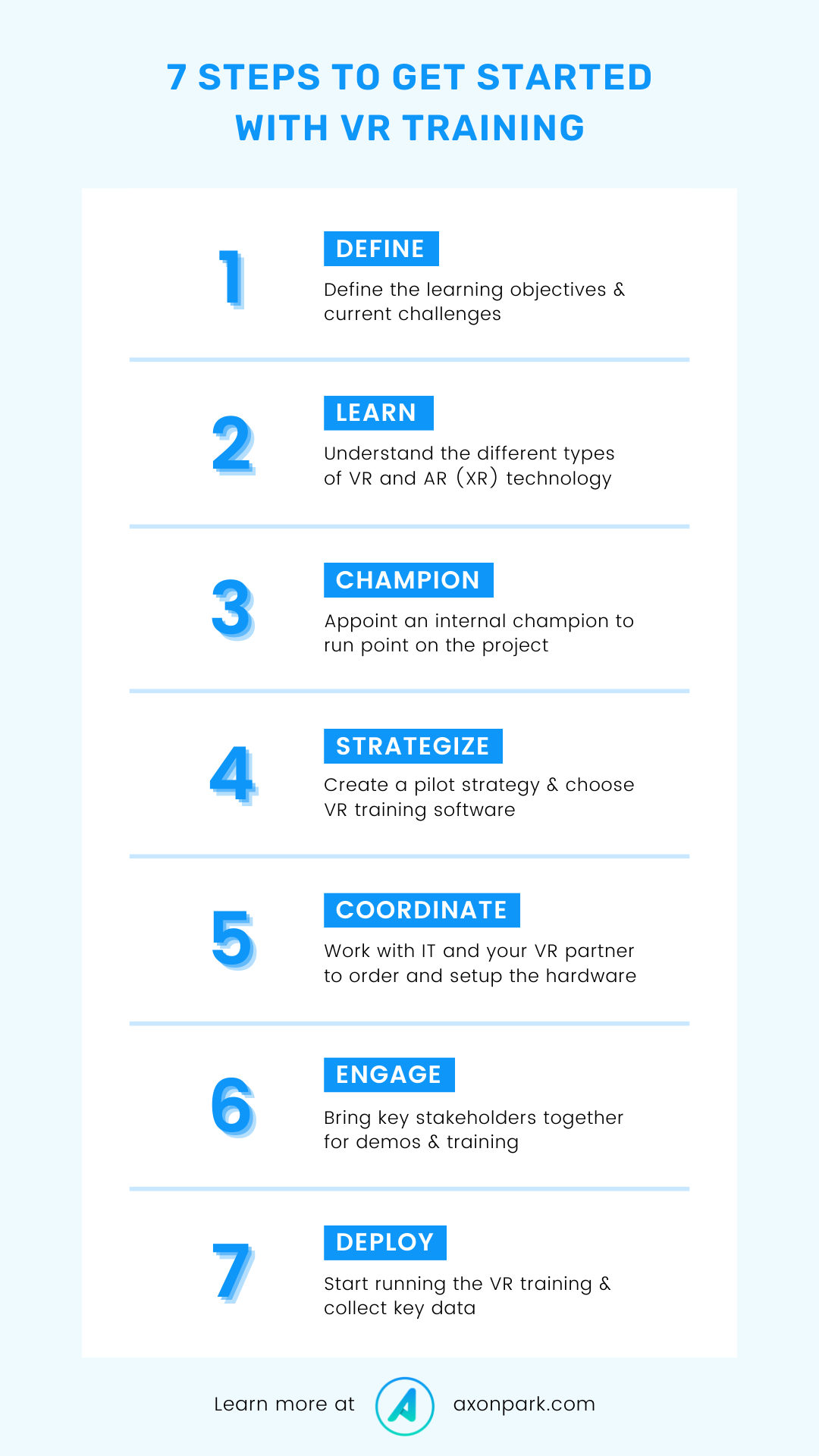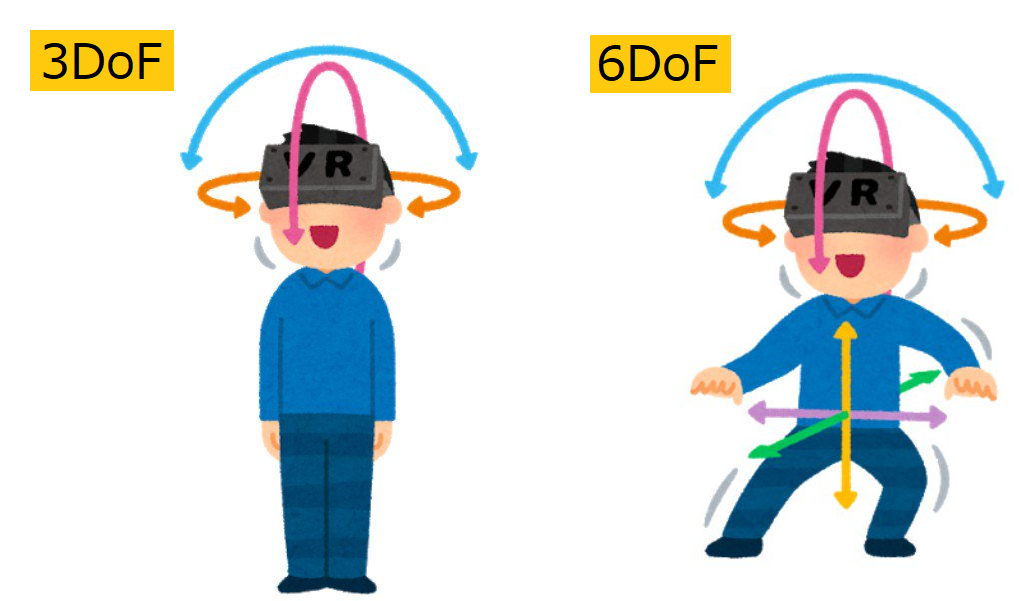As they say, it’s all about timing. The team at Axon Park has been blown away by the daily responses we’re receiving from hospital educators and administrators who are looking to take their first steps into VR training. They’ve been hearing about the low cost standalone VR headsets like the Oculus Quest 2 or Pico Neo 2, as well as the outstanding benefits of VR for medical training (you can learn more about the benefits in our recent article Medical VR Training Works, Here’s Proof) and they want in. Along with this enthusiasm typically comes a common list of questions around how to actually take the “first step” into the virtual world. To help address these questions, we have created a guide to demystify the process. For information around the general costs of starting, you can read our article The Cost of VR Training, but as a quick spoiler, it can end up being as low as $0.11 per 30 minute training session if you spread the cost of the headset over three years. Now without further ado, here are the 7 Steps to Get Started with VR Training.

1) Define the learning objectives & current challenges
Before getting started with VR training, you should take a step back and think about the core learning objectives you are trying to satisfy, as well as the challenges you are currently facing with training in your organization. From here, you can back into a solution that is right for you. Make sure your learning objectives are written down and can be reviewed prior to moving to the following steps. You should then define your current challenges through the same process. Some common challenges we’ve seen from our customers include frustration around scheduling training sessions, access to high quality instructors in alignment with clinical rotations, lack of consistency, significant cost for practice equipment and a lack of data / the manual labor involved with tracking student performance.
2) Understand the different types of VR and AR (XR) technology
Given the nature of the burgeoning immersive technology (XR) industry, you should take a moment to understand the difference between the technologies available. To start, you should understand the concept of the “Extended Reality (XR) Spectrum”.

On one end of the spectrum, you have fully immersive virtual reality, this is where every photon entering your eye is virtually created, essentially transporting you to a new world. On the other end, nestled right up against the real world, you have augmented reality. This is when you may only have a few bits of data overlaid on the physical world. We find that both types of technology have unique utility, for example virtual reality is great for embodied skills training, whereas augmented reality is great for just-in-time support like assisting with surgery in the OR. Next you should understand the difference between interactive experiences and 360 video.

Source – Endabates
In an interactive experience, the user may be using what is known as 6 Degrees of Freedom (6DoF), meaning they can move naturally around the space, using their arms and hands to reach into the VR world and interact with virtual objects. This is also commonly known as a roomscale experience, in which the user can walk around the virtual space as if it were the real world. On the other hand, you have 360 video, or spherical video as some call it, in which you see real video all around you. This is considered to be 3 Degrees of Freedom (3DoF) because you can’t move around the space. This is helpful when you need to see a scene exactly as it is in real life, but don’t need to interact with it. When the video is captured, it’s locked and isn’t interactive, much like when you film any other regular video. I personally call this scarecrow VR, like your body is attached to a pole and you can only look around.
3) Appoint an internal champion
Like with the adoption of any new system or tool, you should have a passionate individual who takes ownership of the process. When it’s said and done, setting up VR training within an organization is relatively simple, however it does require management just like any other project. If you have someone on the team who is passionate about the technology and can manage the initial demos and evangelism of the product, you will find the momentum to continue within your organization, and eventually you will hit a tipping point where your staff knows how to use the tools and can support others. Finding this person is often a natural process, with people who are most enthusiastic about the technology stepping up and volunteering for this type of role.
4) Create a pilot strategy & choose VR training software
Once you have completed the first three steps, the initial champion and budget holders should work together to define a pilot strategy that makes sense for your organisation. At this stage, you should research the market and pick a software and content solution that works for your team. We have clients who start with 20 licenses, all the way up to groups who are looking to kick off the initiative hospital wide with thousands of users. One you have defined what type of training you will provide and who is going to get the initial VR training, you should define how you will measure and manage the impact of the program. One your organization can see the measurable time, labor and cost savings associated with the VR training, it will be easier to make the business case to scale up the training through the organization.
5) Work with IT to order and setup the hardware
Next you should align with your IT team internally to order whatever hardware is necessary and set up the software systems. We work closely with our clients to help with this process to make the solution as simple and turnkey as possible. Once the hardware is set up, it becomes quite straightforward to manage and maintain. Depending on the type of training and frequency of use, the number of required VR headsets can vary. For example, with 65% utilization over an 8 hour day, with 30 minute training sessions, Monday through Friday, you can achieve 2,400 sessions per year with just one headset. For more information about hardware cost and utilization, you can read our article, also mentioned above, outlining The Cost of Medical VR Training.
6) Bring key stakeholders together for demos & training
Now that you have everything setup, installed and ready to go, you should set up a time with your key stakeholders to run through the demos and provide the initial training on how to use the VR system. You should ensure that the internal champion is available to support on these demos and answer any questions. Along with this, you should request that your VR training software provider support your team with this initial meeting to ensure the first set of demos run smoothly. Once the key stakeholders within your organization have a clear understanding of how the experience works and are engaged in the process, it will make it much easier to get buy-in for further rollouts. They say “seeing is believing” with VR, so oftentimes the key is just getting people into the headsets.
7) Start running the VR training & and collect data
At this point, you are ready to start implementing the initial VR training within the organization. We always recommend that users are supported by an internal champion or other user who has experience using the program, before moving on to use the system on their own. After a user has gone through the process once, they can typically checkout the system on their own, login and complete the training. Once you have started to implement the training with staff, you should consciously collect relevant data to understand the efficacy and resource impact on your organization. This should provide you with a sense of whether the course is working for your team and inform next steps on scaling the training internally.
There you have it, the steps required to deploy your first VR training. Of course the level of complexity in each step may vary depending on the content you’re looking to implement and will vary depending on your institution, however this guide should give you a general sense of how the process typically works. We’ve seen organizations go from idea to implementation within weeks, and they’re often surprised by the simplicity and user friendliness of the technology once it’s up and running. If you are interested in taking your first steps with VR training, it’s our mission at Axon Park to support you in this process and make it a great first experience. You can always reach out to us through our contact page or any of our social channels on Twitter, Instagram, LinkedIn and Facebook.



